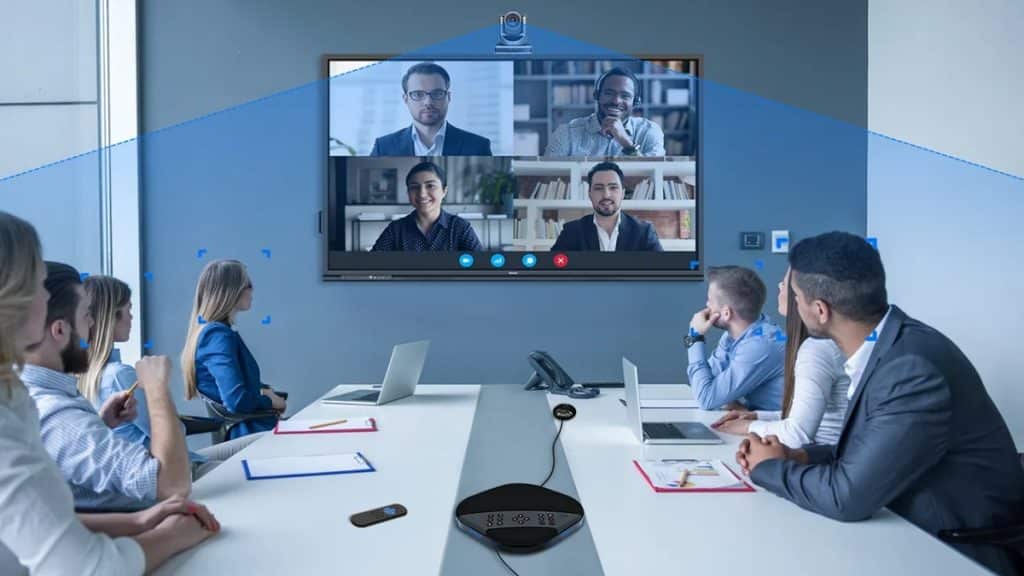In today’s digital world, businesses are rapidly changing how teams collaborate. Smart meeting rooms, powered by AI and advanced video conferencing equipment, are becoming the new standard for enhancing productivity. These setups are transforming communication, especially in hybrid work environments.
With AI-driven tools like speaker-tracking cameras, voice recognition, and real-time translation, video conferencing has never been more streamlined. In this article, we explore how AI and video conferencing are revolutionizing meetings, bringing new levels of efficiency and flexibility to modern workplaces.
1. AI-Powered Cameras that Track Speakers
A key advancement in smart meeting rooms is the use of AI-powered cameras that automatically focus on whoever is speaking, eliminating manual adjustments for a smoother video conferencing setup. These cameras track participant movements, adjusting panning and zooming without intervention, making remote attendees feel more engaged and connected.
Beyond basic motion detection, these cameras distinguish between voices and adjust focus accordingly, enhancing both sound and video quality. This ensures everyone in the room is captured, avoiding awkward fixed shots and creating more inclusive, efficient meetings.
2. Real-Time Transcription and Automatic Note-Taking
AI-powered platforms like Webex and Microsoft Teams boost meeting efficiency with real-time transcription and automatic note-taking, eliminating the need to manually capture details.
Transcription converts speech to text as the meeting happens, useful for participants in noisy environments or those who prefer reading. Automatic note-taking summarizes key points, ensuring important information is easily accessible.
These tools are especially helpful for global teams, offering live translation to bridge language barriers. Whether using a basic setup or an advanced smart room, AI ensures no important details are missed, enhancing productivity.
3. Smart Speakers with Voice Recognition
Another breakthrough in smart meeting rooms is the integration of smart speakers equipped with voice recognition. These devices, similar to Amazon Echo or Google Nest but tailored for professional environments, are designed to interact with meeting participants and execute commands based on voice prompts.
Imagine starting a meeting by simply saying, “Begin the video conference,” or asking the speaker, “What’s the agenda for today?” Smart speakers in modern meeting rooms can do just that. They are integrated into the overall setup and can be programmed to handle tasks like scheduling meetings, retrieving documents, or even managing lighting and temperature settings in the room.
Moreover, these smart speakers can recognize individual voices and adapt their responses accordingly. For instance, if a specific participant asks about a report, the system can retrieve personalized data or files relevant to that individual. This level of customization saves time and ensures meetings are more focused and efficient, allowing teams to focus on discussions rather than logistics.
4. AI-Enhanced Noise Reduction
Effective communication during a video conference often hinges on sound quality. Background noise, echo, or multiple people speaking at once can significantly disrupt a meeting. AI is solving these problems through enhanced noise reduction technologies, ensuring that meetings are clearer and more professional.
The best AI tools for video conferencing include platforms that integrate advanced noise reduction systems. These tools can distinguish between human speech and background noise, filtering out distractions in real time. This is particularly helpful for remote participants joining from noisy environments, like cafes or open offices. By minimizing interruptions, AI-powered noise reduction keeps conversations clear and ensures that meetings run smoothly.
Most high-end video conferencing equipment now comes with built-in AI noise reduction, making it easier to maintain professional audio quality. These tools reduce the need for participants to repeat themselves, leading to more efficient and productive meetings.
5. AI-Driven Insights and Analytics
Beyond the immediate benefits of better sound and video, AI is also helping companies gather valuable insights from their meetings. AI-driven analytics can track various metrics during video conferences, such as speaking time per participant, engagement levels, and even sentiment analysis. These insights can be used to evaluate the effectiveness of meetings and identify areas for improvement.
For example, AI can monitor how much time is spent on each agenda item, how often certain participants contribute, and even detect if participants seem disengaged or distracted. These insights are invaluable for optimizing future meetings, ensuring that time is used wisely, and that all voices are heard.
Platforms like Zoom and Webex already offer basic versions of these features, allowing businesses to analyze how their meetings are conducted. By integrating this capability into their video conferencing setup, companies can ensure that their meetings are not only productive but also provide actionable data to refine collaboration strategies moving forward.
AI and Video Conferencing: The Future of Smart Collaboration
The rapid evolution of AI and video conferencing technology is undoubtedly reshaping the modern meeting room. With AI-powered cameras, voice recognition, real-time transcription, and enhanced noise reduction, the future of collaboration is smarter, more inclusive, and more efficient than ever. Businesses that embrace these technologies will find themselves at the forefront of this transformation, reaping the benefits of improved communication and streamlined processes.
It’s not just about upgrading your video conferencing setup; it’s about fundamentally changing how teams work together. By adopting AI-driven solutions, organizations can enhance the quality of their meetings, empower remote employees, and ensure that collaboration is as seamless as possible. Whether you’re a small business or a global enterprise, investing in smart meeting room technologies can revolutionize the way you conduct meetings and collaborate across distances.
